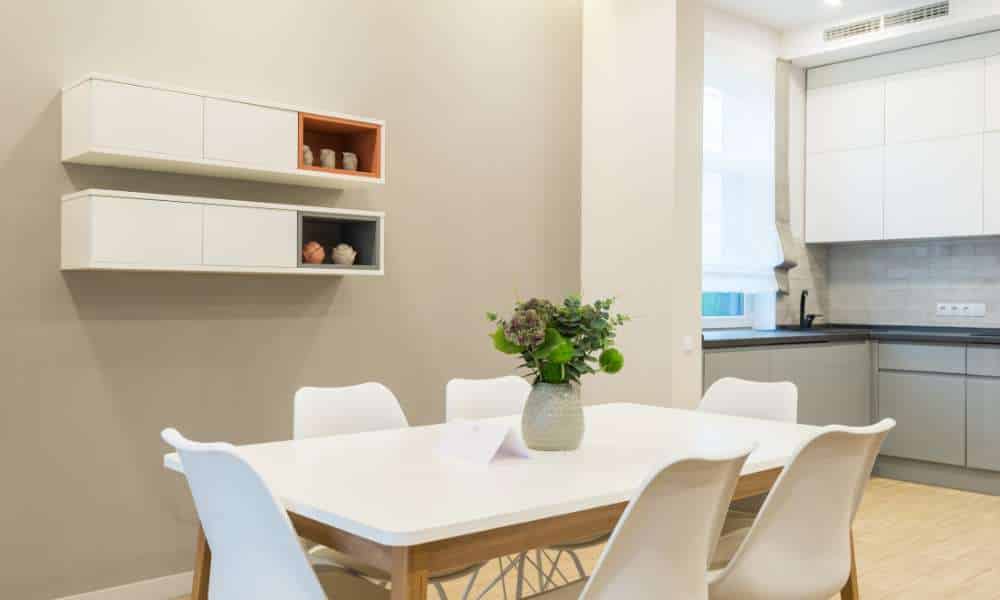Choosing the right dining table for your home is crucial, especially when working with limited space. In particular, fitting a dining table into a 9×10 room presents a unique challenge. The right table can enhance the functionality and aesthetic appeal of your dining area, making it a welcoming space for meals and gatherings. In this article, we will explore how to select the perfect dining table size for a 9×10 room, ensuring you make the most of your available space without compromising on style or comfort. Whether you’re hosting family dinners or enjoying a quiet meal, the right table can transform your dining experience.
Understanding Room Dimensions
A 9×10-foot room provides a compact space that requires careful planning to accommodate a dining table comfortably. This dimension means you have 90 square feet to work with, which includes not just the table but also the necessary clearance for movement and additional furniture. It’s essential to account for the space needed around the table for chairs to be pulled out and for people to move freely. Properly planning this layout ensures that your dining area is both functional and inviting, preventing the room from feeling cramped and allowing for an enjoyable dining experience.
Standard Dining Table Sizes
Dining tables come in various sizes and shapes, each fitting differently into a room. Common shapes include round, square, rectangular, and oval. Round tables are ideal for small spaces and promote conversation, typically ranging from 36 to 60 inches in diameter. Square tables offer a balanced look and can range from 36 to 60 inches per side. Rectangular tables, perfect for longer rooms, usually measure 30 inches in width and vary from 48 to 96 inches in length. Oval tables provide a softer look and can fit into narrower spaces, with dimensions similar to rectangular tables. Understanding these standard sizes helps ensure a table fits well without overwhelming the space.
Measuring Your Space
To measure your space for a dining table, start by using a tape measure to record the length and width of the room, noting the 9×10 dimensions. Mark out the table’s potential location with painter’s tape on the floor. Ensure to leave at least 36 inches of clearance around the table for chairs and movement. Consider doorways, windows, and other obstructions, measuring their positions and factoring them into your layout. Account for any additional furniture like sideboards or cabinets. This careful planning helps ensure your dining area is both functional and aesthetically pleasing, avoiding cramped spaces and maintaining a smooth flow.
Space Allowance Around the Table
When placing a dining desk in a room, it’s essential to allow enough space around it for comfort and movement. Ideally, you should leave at least 3 feet (36 inches) of clearance on all sides of the table. This space ensures that chairs can be easily pulled out and people can move around without obstruction. For optimal functionality, consider leaving a bit more space if possible, especially in high-traffic areas. This allowance not only makes dining more comfortable but also enhances the overall flow and usability of the room, preventing a cramped and cluttered feel.
Choosing the Right Shape
Choosing the right shape for your dining table is crucial in a 9×10 room. Round tables are excellent for maximizing space and encouraging conversation, but they can limit seating capacity. Square tables provide a balanced look and fit well in smaller rooms but may not be ideal for larger gatherings. Rectangular tables, while great for accommodating more guests, can dominate the room and make it feel cramped. Oval tables offer a compromise, providing the length of a rectangular table with a softer, more space-efficient design. For a 9×10 room, round or oval tables are often the best choices, as they maximize space and enhance usability without overwhelming the area.
Seating Capacity and Comfort
Determining the appropriate seating capacity for a dining desk in a 9×10 room involves balancing space and comfort. Generally, a round table with a diameter of 42-48 inches can comfortably seat four to six people, while a rectangular table measuring 60 inches in length can accommodate six chairs. To ensure comfort without overcrowding, allow at least 24 inches of table width per person. Additionally, ensure there’s enough room around the table for people to move freely, leaving at least 3 feet of clearance on all sides. This approach helps maintain a comfortable dining experience, avoiding a cramped or congested feel.
Multifunctional and Extendable Tables
Multifunctional and extendable tables are excellent solutions for small spaces like a 9×10 room. These tables can be adjusted to meet varying needs, featuring extendable leaves that expand the seating capacity when needed and fold away when not in use. Some designs also include built-in storage, adding further functionality. The primary benefit of these tables is their versatility, allowing you to maximize your space without sacrificing functionality or style. They provide flexibility for hosting larger gatherings while maintaining a compact form for daily use, making them ideal for optimizing both space and usability in a small dining area
Alternative Solutions
When traditional dining tables seem impractical for a 9×10 room, consider alternative solutions like breakfast nooks or bar tables. A breakfast nook can be a cozy and efficient use of space, often featuring built-in benches that provide storage underneath. Bar tables, with their taller profile, can fit into tighter spots and offer a contemporary dining experience. Additionally, wall-mounted drop-leaf tables can be folded down when not in use, freeing up valuable floor space. These creative alternatives not only maximize dining space but also add unique style elements to small rooms, making them both functional and aesthetically pleasing.
Practical Examples and Visual References
Practical examples can provide valuable insight when selecting a dining desk for a 9×10 room. Visual references, such as photos or diagrams, showcase how well-fitted tables can enhance the space. For instance, a round table with a diameter of 42 inches, paired with armless chairs, can create a cozy dining area without overwhelming the room. Homeowners have also shared testimonials about using extendable tables, praising their versatility for both daily meals and entertaining guests. These case studies highlight successful layouts, demonstrating how thoughtful planning and design choices can make a compact dining space both functional and stylish.
Conclusion
Choosing the right dining table for a 9×10 room involves careful consideration of space, table shape, seating capacity, and functionality. By understanding the room dimensions and allowing adequate space around the desk, you can ensure a comfortable and efficient layout. Exploring different table shapes and multifunctional options helps maximize usability without compromising on style. Alternative solutions like breakfast nooks or bar tables offer creative ways to optimize small spaces. Practical examples and visual references further illustrate how thoughtful choices can transform a compact dining area into a welcoming and functional space. With these insights, you can confidently select the perfect eating table that enhances both the aesthetics and practicality of your home.





